5 Mistakes Dentists Make With Dentist SEO That Hurt Their Rankings (Bonus: FREE Dentist SEO Routine)
by
Jeremy Tang - Updated
15-Oct-2024
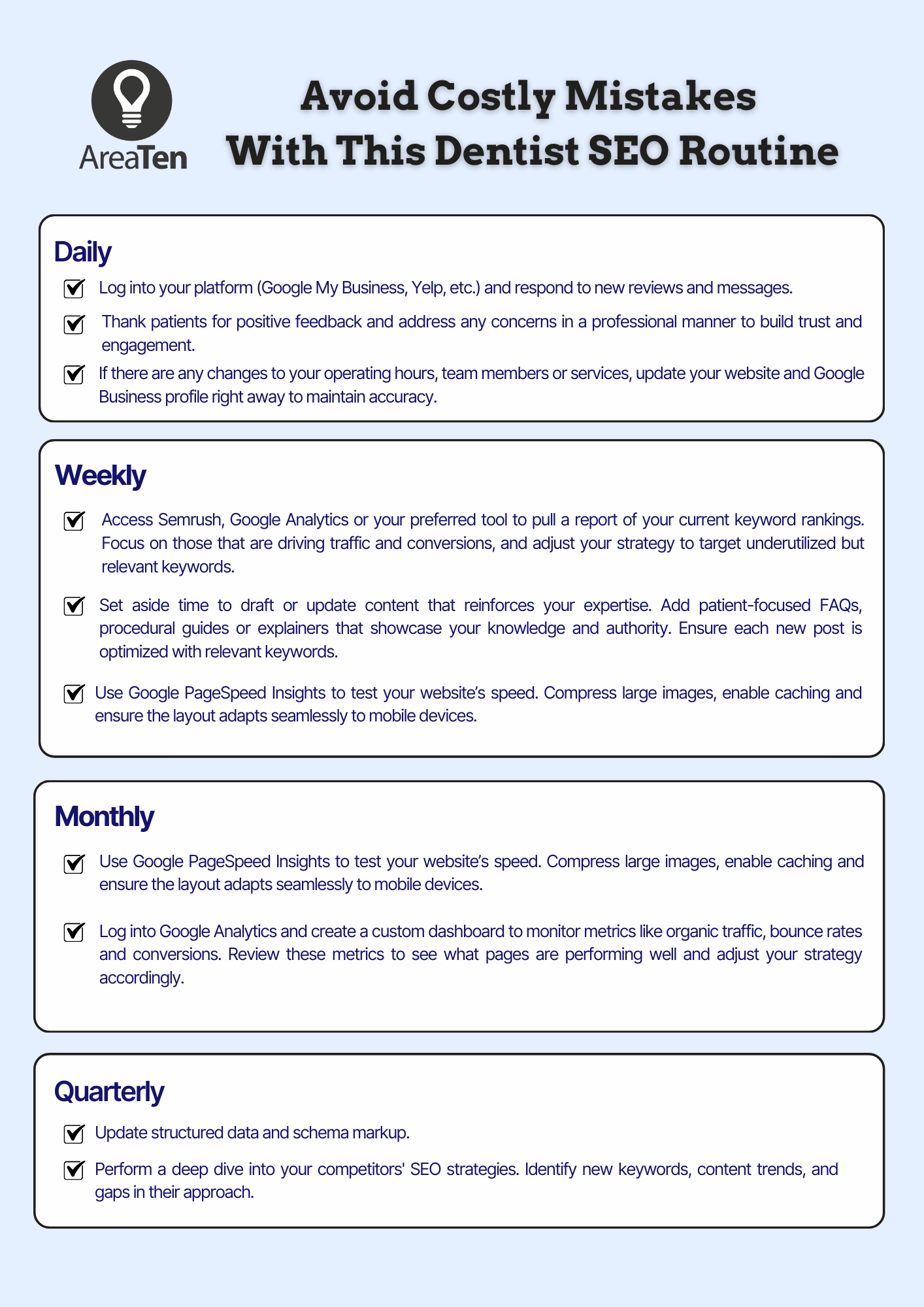
Dentist SEO is often bogged down by mistakes like ignoring hyper-local keywords, overlooking EEAT and neglecting structured data. With Area Ten’s tailored SEO strategies, you can fix these errors, build trust and increase patient engagement, leading to better online visibility and more bookings.
A lot of dentists are missing out on one simple thing that can really boost their local SEO strategy: hyper-local keywords.
Here’s the thing—local searches are powerful. In fact, 88% of people who search for a local service on their phone visit that business within a week (Source: Think with Google). That’s huge. But here’s where many dental practices drop the ball: they only focus on broad local keywords like “dentist in [City].”
Now, if you only target those general city-wide terms, you’re likely missing out on patients right in your neighborhood who are actively searching for a dentist nearby. By shifting focus to hyper-local keywords like “dentist near [Neighborhood],” you can show up for those patients who are ready to book an appointment—not miles away, but right around the corner.
Ignoring Google’s EEAT (Experience, Expertise, Authoritativeness and Trustworthiness) guidelines is a surefire way to lose out on both rankings and patient trust.
Patients are smart. They use the internet to vet healthcare providers, and if your site doesn’t clearly show off your expertise or make pricing easy to understand, they’re likely to look elsewhere. People want to feel confident in their choice, especially for more expensive treatments like implants.
Boosting patient engagement with clear, transparent content doesn’t have to be complicated. It’s all about speaking their language and addressing their concerns in a way that builds trust and makes them feel understood.
Let’s start with Google’s “Who, How, and Why” framework. 
Another easy way to ease patient concerns and build trust is by being upfront about your pricing. When you show starting prices for common services—like teeth cleaning, cavity fillings, cosmetic procedures and even follow-up appointments after things like wisdom tooth extractions—you take the mystery out of the process. And that’s something patients appreciate.
Don’t forget to highlight any available subsidies, insurance coverage or financing options too. This kind of transparency makes your practice more accessible to a broader range of patients and strengthens that trust even further.
It’s easy to get caught up in creating killer content.
That said, great content alone won’t save you if the technical stuff is a mess. You may have a lot of useful content ready and waiting to be found, but if your page takes forever to load or the content doesn’t show properly on mobile devices, what happens? People leave.
Frustrated users are more likely to hit the back button than stick around to engage with your content. After all, why should they bother with a broken website when other options work just fine?
Patient testimonials and success stories are like magic when it comes to building trust and engagement.
Did you know that 81% of people check out reviews on Google before picking a healthcare provider (Source: Forbes)? Also, 91% of people say that local reviews affect how they perceive brands (Source: BrightLocal). When the numbers are this high, it’s easy to see why patient testimonials are such a game changer.
When potential patients read reviews, they’re going to start envisioning themselves in those stories. This will be your chance to prove that you’re not just another company looking to make money; you’re someone they can trust. And when that trust starts to build, your prospects are more likely to take action—whether it’s booking an appointment or exploring more about what you offer.
Using long tail keywords can make a real difference in how visible your niche services are online.
These aren’t your typical broad search terms like “dentist” or “dental clinic”— long tail keywords are specific, multi-word phrases like “pediatric dentist that accepts Medicaid” or “way to search dentist by insurance.” Although they get less traffic overall, the beauty of long tail keywords is that they tend to attract high-intent searchers.
These are the people who know exactly what they need and are more likely to take action, like booking an appointment, compared to someone casually browsing.
Sure, using broader keywords can drive more general traffic, and that’s important. But when you’re trying to get users to convert into customers, it’s these highly specific searches that really matter. When you build content around these precise phrases, you’re effectively guiding potential patients directly to the service they’re after.
Improving patient engagement on your website is easier than you think. Just implement these smart on-page optimization tactics:
Just by implementing good on-page SEO step-by-step, you’ll be able to enhance engagement and build your credibility, leading to more bookings and better performance metrics.
Schema markup is a tool often overlooked in dental SEO campaigns.
When businesses do take advantage of it, they usually just go for the generic LocalBusiness schema option.
Instead, you should opt for schemas that are specific to your business, like Dentist or MedicalOrganization. Why? Because if you do, you’re giving search engines a richer, clearer understanding of your practice.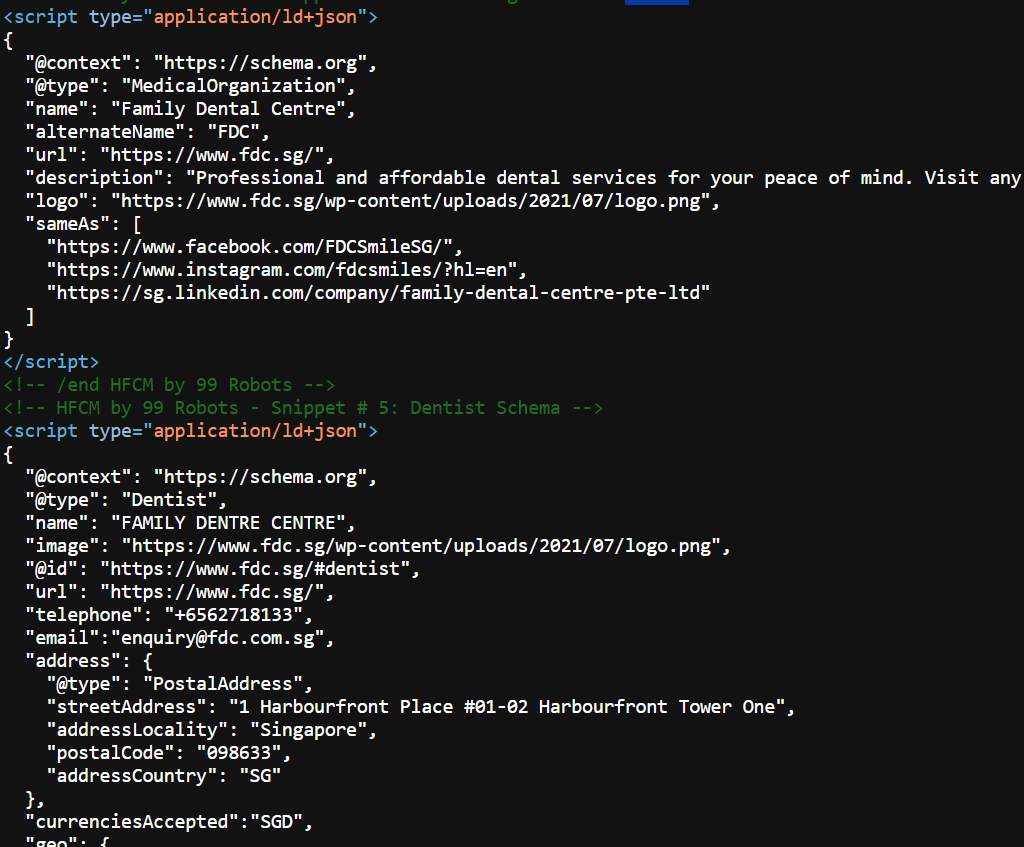
This can then lead to enhanced search visibility through rich snippets, which showcase your ratings, pricing, hours and more.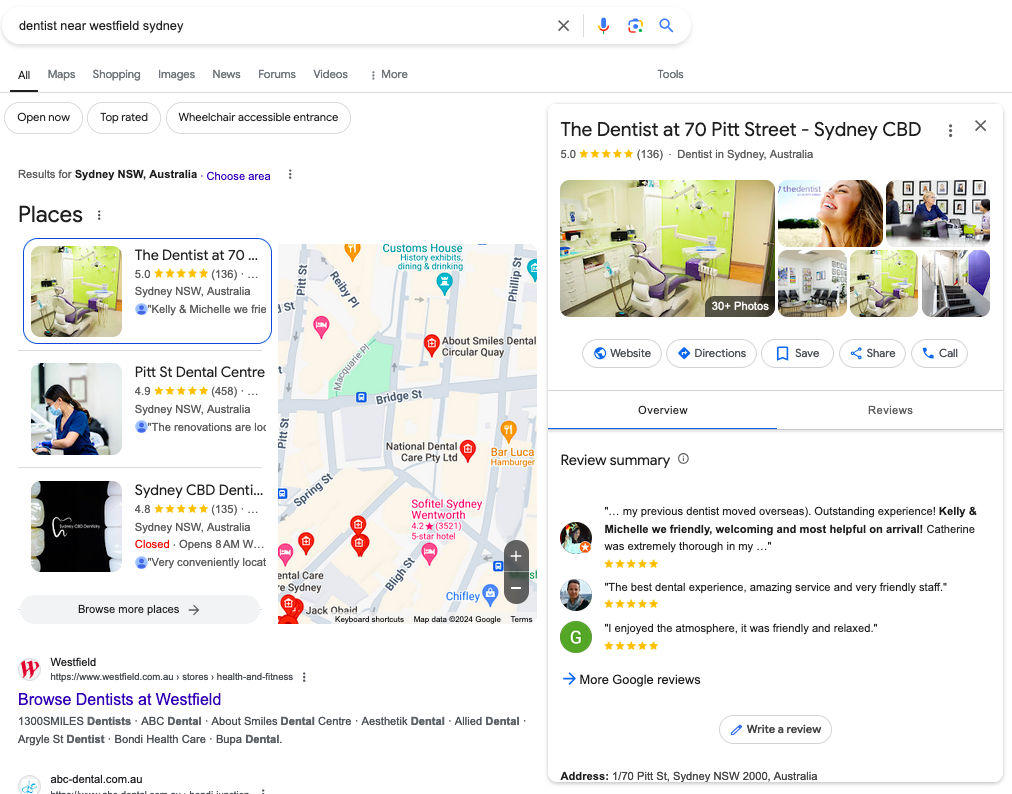
Imagine this: you’re searching for a dentist. One result just lists a name and address. But another pops up with glowing reviews, business hours and even pricing info—all right there on Google’s page. You’re probably going to click on the latter.
That’s the power of rich snippets, all thanks to schema.
The sad reality is, a lot of dental practices drop the ball when it comes to using schema markup. With over half of patients checking out online reviews before they even think about booking with a new provider (Source: Stanford), not taking advantage of proper schema implementation is a huge missed opportunity.
Adding schema to your website might seem a bit complicated at first, but with today’s tools, it’s much easier than you think.
For example, using ChatGPT for schema markup is a great idea. Here, you can generate the necessary schema code just by providing ChatGPT with your clinic’s information.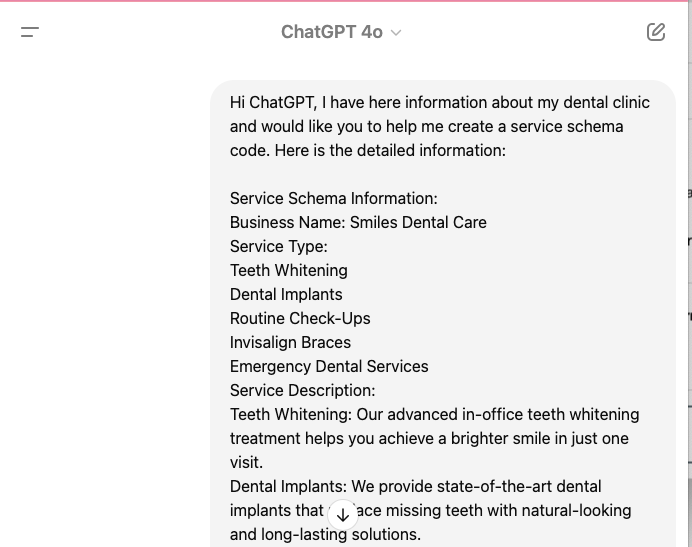
For your service schema, just make sure it covers the essentials. Start with your dental clinic’s name, the specific services you offer (like teeth whitening or dental implants) and a short description for each one. It’s also a good idea to highlight the areas you serve, your clinic hours, contact details, pricing and payment options.
When it comes to your patient review schema, you’ll want to capture key details like the reviewer’s name, review date, star rating and a quick comment about their experience (something like “Great service and super friendly staff!”). If you’ve got multiple reviews, showing the average star rating and the total number of reviews will help boost credibility and trust.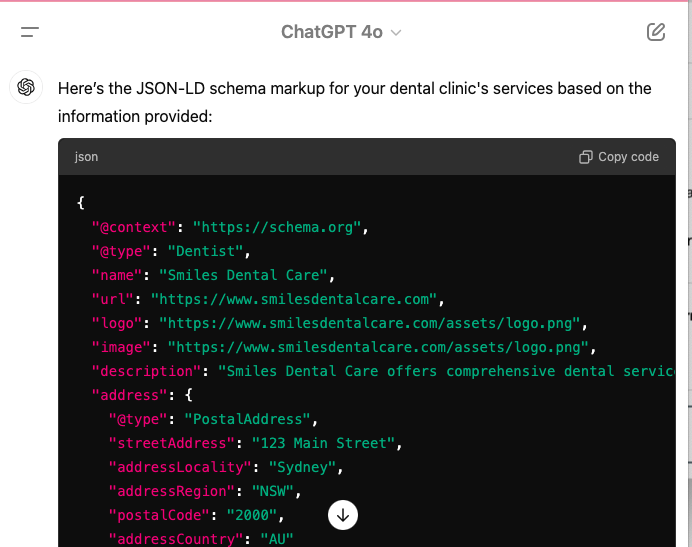
Once the JSON-LD code has been generated, you can add it directly to the <head> section of your HTML. Then, all you have to do is test your schema out with Google’s Rich Results Test or the Structured Data Testing Tool and publish.
So many businesses focus on clicks, views and visits, thinking that those numbers alone tell the whole story. But here’s the truth: website traffic is just one of the healthcare SEO considerations you should keep an eye on.
At the end of the day, what matters most for your business are conversions. And for a dentist, that means patient inquiries and bookings. If you’re not looking at how many of those website visitors are actually turning into booked appointments, you’re flying blind.
Looking to make your SEO strategies even better? Real-world data is your best friend.
After all, how can you make informed changes to what you’re doing if you don’t know what’s actually happening? Tools like Google Analytics or dental CRM platforms give you a front-row seat to see how much your keywords and landing pages are pulling their weight. You’ll quickly see what’s working and, just as importantly, what’s not.
Maybe there’s a page that’s pulling in loads of traffic but barely converting. That’s a red flag you can’t ignore. Perhaps you just need to change the call to action or give the page a full content and layout overhaul.
Just like how a good dental routine keeps your patients from facing expensive problems, sticking to a solid SEO routine can keep your website in great shape and ahead of the competition. That’s why we’ve put together this handy guide to help you dodge common SEO slip-ups and keep those rankings strong.
Download your own copy here: Dentist SEO Routine
If you’re looking to boost your dental practice’s visibility, don’t just look for any dental SEO consultant Australia has to offer. What you need is Area Ten’s tailored dentist SEO strategy.
In medical SEO, efforts for marketing often fall short. Compliance regulations, the complexity of health-related content and the need for trustworthiness set a high bar for online visibility. And the truth is, many dental practices struggle to balance these demands while also reaching new patients.
That’s where we step in. Area Ten offers an approach built to address the precise challenges that healthcare professionals face in SEO.
With over a decade of experience working with companies like yours, we know what it takes to comply with YMYL (Your Money Your Life) standards while optimizing for SEO. This balance is crucial in your industry, where credibility and trust are as important as search rankings. Our team works behind the scenes so you can focus on what matters most—caring for your patients.
We’re not just a good dental SEO consultant; we know how to integrate Google’s EEAT guidelines into everything we do, positioning your dental practice as a trusted source.
This involves meticulous keyword research, allowing you to zero in on the most impactful terms to target. Then, we implement our effective SEO copywriting strategies, creating compliant content that not only ranks well but also answers patient questions, builds trust and positions your practice at the top of their minds when they need a reliable healthcare provider.
Imagine having a system that creates SEO-optimized content for you on autopilot.
That’s what CMAX is all about. It’s designed to generate thousands of unique, quality and compliance-safe pages, each one hitting those long tail and hyper-local keywords that your competitors tend to overlook.
The best part? It’s all customized to your brand, as it takes content that you’ve approved as the basis for everything it produces. That means you get precise, brand-safe results without worrying about duplicated content or inaccuracies.
Human insight is a big part of what makes CMAX so great. Thanks to our ongoing data analysis, keyword research and strategy tweaks, CMAX is able to use new insights to keep your content fresh and competitive without breaking a sweat. It’s like having an SEO strategy that never stops evolving, allowing you to scale up your business rapidly without sacrificing compliance.
Area Ten’s turbocharged SEO acceleration is just what your dental practice needs to get to the top.
With our programmatic SEO services, we can grow your website’s organic traffic 4x faster than traditional methods, all with minimal effort on your end. We handle everything, leveraging cutting-edge technology and our deep industry expertise to help your brand break through the clutter and scale at 10x the scale.
Forget the outdated and confusing practices that leave most businesses stuck. We’re the top SEO agency for dentists and other types of businesses, offering crystal clear solutions that work every time.
If you’re tired of spinning your wheels, let’s get you real, lasting results—fast. Inquire now about our FREE SEO Fast Track and push your business forward with technology that’s built to win.
Book a free video consultation below to see how your SEO & Paid Media campaigns are performing against global benchmarks in your industry.
We’ll uncover tangible opportunities to grow your business in just 6 weeks, including: